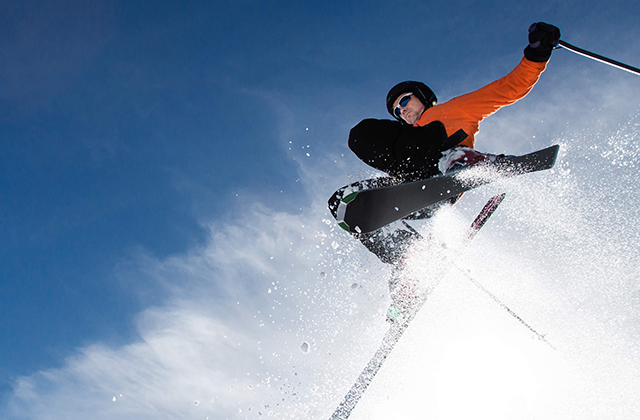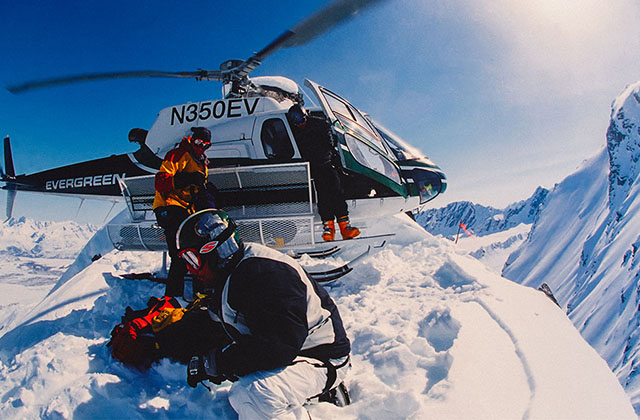Ski touring, AT skiing, ski mountaineering, randonee … whatever you call it, getting into the backcountry on skis is becoming more and more popular and other are getting Canada ski packages.
The idea of escaping into nature and away from the crowds—and enjoying untouched snow—may sound really good, but where do you start? There are two essential components, education and gear. We’ll tackle the equipment question in this article; you can learn how to get an education in backcountry safety here.
But before you consider what equipment you’ll want to acquire, think about where you’ll be skiing, how you plan on skiing, and the type of terrain you’ll most often encounter while skiing. The difference between a ski-mo/randonee racing rig (super lightweight, designed more for speedy ascents) and a sidecountry rig (resort-friendly and not intended for a lot of skinning) is vast. While often-heard logic of “light is right” will generally hold true for most touring setups, the balance of lightness and fun is crucial and largely dependent on your end goal. A heavier setup will likely require at least one solo rest day in the hut during your five-day tour while the rest of the crew is slaying; similarly, a race rig will leave you sinking and wallowing on the deepest days of the year. Remember, you’re aiming for fun—don’t let peer pressure or bargains steer your decision.
Below is a list of the essential gear you’ll need to head out on your first ski tour. Always remember, however, that no gear is substitute for training and experience—take an avalanche safety course and practice regularly with your avalanche beacons before heading into backcountry ski terrain.
Skis
Any downhill ski can theoretically be set up for use in the backcountry, but alpine touring skis designed specifically for backcountry use usually feature lighter weight designs that make hiking uphill drastically easier.
Backcountry/alpine touring/ski mountaineering skis (the terms are used interchangeably) range from super-svelte trekking and racing styles focused primarily on uphill mobility and speed, to more freeride-focused models that offer the same massive dimensions and innovative rocker profiles as the newest inbounds powder skis. Many backcountry skis offer touring features like notches in the tip and tail for attaching climbing skins. Along with low weight comes some sacrifice in another areas, usually in the ski’s ability to remain damp and chatter-free on hard snow or to resist impact damage to the base and edges. So if you’re not planning to spend the majority of your time hiking for untracked lines, you might be better off sticking with a “resort” ski.
Skins
Skins are pre-cut or ready-to-cut sections of plush material that stick to the bottom of your skis and allow you to travel uphill without sliding back down. This is because they have a ‘nap’ that helps grip the snow in one direction, and glide in the other.
Skins are made of mohair, synthetics or a synthetic/mohair blend. Synthetics are durable and grippy, while mohair skins glide with superior speed and efficiency, but may not grip as well as synthetics. Skins with a blend of mohair and synthetic offer a balance of these qualities.
Clips at the tip and tail and a sticky, non-permanent glue compound keep a skin attached to your ski. Most skins use clips that will universally attach to any ski, although pre-cut skins are often designed to interface with holes or notches in particular models of ski.
Some skins are manufactured to fit specific ski models. If one is not available for your ski, you’ll need to buy a skin that’s longer and wider than your ski at its widest point (usually the tip) and trim it to fit. Most skins ship with an easy-to-use trimming tool and instructions.
Bindings
Backcountry touring bindings allow the heel to move freely off of the ski while you’re skinning uphill for an easier, more natural stride. When it’s time to ski down, the bindings lock down in the heel. There are several types of touring bindings: low-profile, lightweight tech bindings that are only compatible with AT boots with dimpled tech inserts, frame-style AT bindings that are compatible with traditional alpine boots, and hybrid bindings, which are a blend of the two.
Ultralight and minimalist by design, tech bindings (originally developed by Dynafit, now available from several brands) only work with ski touring boots with tech-compatible heel and toe fittings. This binding style places a premium on stride efficiency and low weight, rather than adjustability or downhill performance. These bindings didn’t historically feature traditional DIN adjustment, but new options like the Dynafit Beast Binding are indicative of big mountain skier’s desire to adopt tech bindings.
Frame AT bindings accept boots either with traditional alpine soles or lugged AT soles. In general, they feature a frame that encompasses the boot that can be released for the ascent and then locked down for skiing. Downhill performance of many of these frame bindings is comparable to that of standard alpine bindings. However, this advantage comes with increased weight—which will be felt on the skin track.
Hybrid bindings accept boots with tech-compatible toe fittings, but typically have a traditional alpine heel piece. New options such as the Salomon or Atomic Shift binding offer the tech toe piece for the superior uphill performance, but then morph to offer a standard alpine toe cup for superior downhill performance.
Other things to look for in touring bindings include heel risers or climbing wires that can give you a boost under your heel for climbing steep hills. Brakes aren’t standard on some ultralight tech bindings, but can be purchased separately, as can add-on crampons that help with traversing treacherous terrain.
Boots
Touring boots feature a walk mode that allows the cuff to pivot freely for better range of motion when you’re hiking and skinning. They also usually include aggressively lugged rubber soles and lightweight shell material, all of which make the alpine touring boot suitable for gaining altitude. A carbon cuff or tongue, lightweight plastic shell, minimalist buckle design, or honeycomb structure help reduce the weight of an AT boot so you can move faster and feel less fatigued during a long tour. The newest generation of AT boots is highly attuned to downhill performance as well; these boots may be slightly heavier.
Be sure you are getting boots that are compatible with your bindings. A true alpine touring boot’s rockered sole is generally only compatible with pin-style tech bindings and some frame AT bindings that feature an adjustable toe height. Some traditional alpine ski boots, however, can be fitted with removable sole blocks (sold with boots or available separately) to make them swap-able between alpine, frame AT and pin-style AT bindings.
Like traditional alpine boots, AT boots cover a range of flex ratings. Stiffness benefits you during the descent, but it might cause you pain on the skin track—consider whether you prefer superior comfort or performance. A boot’s flexibility on the walk or skin up will also be affected by the range of motion on the walk/ride hinge.
Poles
Backcountry ski poles are essentially the same as your regular ski poles, but they ideally will have an adjustable or collapsible design to adapt to changing terrain. For example, you may want them longer than normal for flat terrain (so you can swing them like cross-country poles), and shorter when you’re ascending steeper terrain.
Now that you have your equipment assembled, what else do you bring along? It will depend on how long you expect to be out and how far you are going, among other things. There are, however, some things you shouldn’t leave home without.
Backcountry Ski Pack
A good backcountry ski pack is tough, offers a means of carrying your skis if you need to, a mid-sized capacity, and a sleeve or compartment that’s made specifically to hold your shovel, probe and other avalanche rescue tools for quick access. Beyond that, you may be interested in extras like hydration bladder sleeves (just make sure you have an insulated tube) and extra attachment points or compartments for things like your helmet (which you may rather not wear on a sweaty ascent).
At the very least your backpack should allow quick and easy access to your shovel and probe, but some backpacks may help save your life. The first avalanche packs to hit the market with survival features were Black Diamond’s Avalung packs. These feature a system which lets you breathe under the snow and give your partners additional time to dig you out if you’re lucky enough to live through the ride in the first place. Since then, a slew of companies have come out with backpacks featuring airbag systems. If you find yourself in a slide, you pull the oh-crap handle and an airbag deploys to increase your mass and help you stay on top of the debris and minimize your chance of trauma and burial. Neither of these backpacks will guarantee you survive being caught in an avalanche, but they’re much better than nothing.
Avalanche Beacon
Beacons are absolute necessities. Without one you cannot search for someone who was buried in an avalanche, and no one can find you. Some beacons have a lot of bells and whistles, but as a beginner the most important thing to look for is easy and intuitive use. BCA’s Tracker beacons are tried and true entry-level beacons that are ideal for beginners.
However, no matter how simple your beacon may be to use, you need to practice until operation is second nature. Grab some friends, go out in the snow, and bury some packs with beacons in them to practice your search skills. When things go south and lives are on the line, people don’t rise to the occasion, they fall back on their training. Beacons are computers, and computers are only as smart as the people operating them.
When choosing a beacon, there are a number of things to look for, including number of beacons and range. Two or three antenna beacons have quickly become the norm due to their improved distance and directional sensitivity; the three-antenna design is a further improvement that helps to reduce signal spikes when doing close, precise searches. And the greater a beacon’s range, the more likely it is to be able to receive a signal early in the search process.
Shovel
The classic winter tool is a necessity in the backcountry as well—your shovel is used to dig test pits for snow-pack analysis and to excavate other skiers in the event of an avalanche.
A plastic blade isn’t strong enough to dig through concrete-hard avalanche debris. Aluminum is the only choice for safety in avalanche terrain. Some blades offer a serrated edge or pointed shape for extra digging power. Blade size is also a factor; those with larger blades will move more snow, but are harder to manage.
You can choose between shovels with fixed-length shafts and adjustable shafts; A fixed-length shovel is lightweight and makes for easy storage in a backpack, but a shovel with an adjustable-length shaft gives you the potential for more leverage so you can move a lot of snow quickly. Some shafts feature extras like saws or probes stowed inside, to save space in your pack.
Probe
A lightweight folding pole between nine and ten feet long, an avalanche probe is used in an avalanche rescue scenario to probe the snowpack for buried skiers once you locate their general position with an avalanche beacon, enabling you to zero in with accuracy that a beacon can’t provide. This leads to less digging time and a faster recovery, which can save lives.
Puffy Jacket/Extra Insulation Layer
The layers you bring along and/or wear will vary greatly depending on the weather, but even on a bluebird day, having a good warm puffy in the bottom of your pack is always a great idea. Weather can change quickly and if an injury occurs in your group, keeping the person warm will be that much easier.
Extra Gloves
Gloves are a crucial piece of equipment and you’ll need a few pairs—bring a thin fleece pair for skinning up, a midweight leather pair for skiing and transitioning, and an insulated, fully waterproof pair in the bottom of your pack for storm days or challenging weather.
Fuel
This may be totally obvious to the more food-oriented person, but it’s an easy thing to overlook. Skinning to a ridgetop can be sweaty work, so you want to be sure to bring along enough water to avoid dehydration. Likewise, you don’t want to run low on fuel, since you’re likely going to be burning a lot of calories. Even if it’s nothing more than a PB&J or a couple of bars and packets of gel, make sure you have a means of boosting your energy so it’s there when you need it.
Emergency Essentials
The items in your emergency kit will come down to personal preference, but a good multi-tool with a knife, duct tape, a headlamp, a lighter, and one or two adjustable ski straps makes for a great start.
But everyone has their own list of necessities, one that develops out of experience. For example, I now always take a small thermos of hot water on hut/yurt trip approaches. When, after a long slog on the skin track with 50lbs of gear on your back, you find a frozen-solid padlock protecting your shelter from the quickly declining weather conditions in the fading light, your touring partners will celebrate you as a savior when you warm the frozen lock with your magically hot water. Point being—experience is the real teacher, and I learned this one the hard way.
Above all …
You may be all kitted out, but once again, we can’t emphasize enough: know before you go. The most important things you bring into the backcountry are knowledge and good judgment. Good judgment keeps you out of trouble, and knowledge may save you if your judgment comes up short. Unfortunately, judgment only comes from experience.
So, how do you live through the learning curve? You cannot start backcountry skiing with experience, but you can start with some knowledge by taking an avalanche 101 course. Ideally, your first trip into the backcountry with your new gear should take place with an avalanche instructor. If that’s not possible, make sure you’re heading to a safe, low-angle zone with a friend who knows what he or she’s doing and is willing to teach you. Then take a course as soon as you possibly can.
Above all, enjoy! A new world of experiences awaits.



